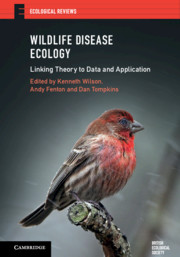Book contents
- Wildlife Disease Ecology
- Ecological Reviews
- Wildlife Disease Ecology
- Copyright page
- Contents
- Contributors
- Preface: Wildlife Disease Ecology
- Glossary of Terms
- Part I Understanding within-host processes
- Chapter one Pollinator diseases: the Bombus–Crithidia system
- Chapter Two Genetic diversity and disease spread: epidemiological models and empirical studies of a snail–trematode system
- Chapter Three Wild rodents as a natural model to study within-host parasite interactions
- Chapter Four From population to individual host scale and back again: testing theories of infection and defence in the Soay sheep of St Kilda
- Chapter Five The causes and consequences of parasite interactions: African buffalo as a case study
- Chapter Six Effects of host lifespan on the evolution of age-specific resistance: a case study of anther-smut disease on wild carnations
- Chapter Seven Sexually transmitted infections in natural populations: what have we learnt from beetles and beyond?
- Part II Understanding between-host processes
- Part III Understanding wildlife disease ecology at the community and landscape level
- Index
- Plate Section (PDF Only)
- References
Chapter Six - Effects of host lifespan on the evolution of age-specific resistance: a case study of anther-smut disease on wild carnations
from Part I - Understanding within-host processes
Published online by Cambridge University Press: 28 October 2019
- Wildlife Disease Ecology
- Ecological Reviews
- Wildlife Disease Ecology
- Copyright page
- Contents
- Contributors
- Preface: Wildlife Disease Ecology
- Glossary of Terms
- Part I Understanding within-host processes
- Chapter one Pollinator diseases: the Bombus–Crithidia system
- Chapter Two Genetic diversity and disease spread: epidemiological models and empirical studies of a snail–trematode system
- Chapter Three Wild rodents as a natural model to study within-host parasite interactions
- Chapter Four From population to individual host scale and back again: testing theories of infection and defence in the Soay sheep of St Kilda
- Chapter Five The causes and consequences of parasite interactions: African buffalo as a case study
- Chapter Six Effects of host lifespan on the evolution of age-specific resistance: a case study of anther-smut disease on wild carnations
- Chapter Seven Sexually transmitted infections in natural populations: what have we learnt from beetles and beyond?
- Part II Understanding between-host processes
- Part III Understanding wildlife disease ecology at the community and landscape level
- Index
- Plate Section (PDF Only)
- References
Summary
A large class of diseases is dependent on juvenile hosts for transmission because younger hosts are typically more susceptible to disease. Studies have investigated the epidemiological consequences of juvenile susceptibility, but why species retain such high susceptibility in the juvenile stage remains a puzzle. Life-history theory predicts that hosts should evolve to be more resistant as juveniles than as adults because early infection is costlier. Studies of anther-smut on wild carnations show that disease persistence is strongly dependent on the presence of a highly susceptible juvenile class. While there is evidence of genetic variation in juvenile resistance, the majority of plant families are highly susceptible at this stage, so juvenile resistance may be less beneficial than assumed. To understand how the costs and benefits of resistance and life-history traits affect the evolution of age-specific resistance, we developed a general analytical model of age-specific resistance, which shows that if there is genetic variation for the onset of resistance, selection and numerical feedbacks often drive the evolution of adult resistance but maintain juvenile susceptibility. The implications of these results are discussed.
Keywords
- Type
- Chapter
- Information
- Wildlife Disease EcologyLinking Theory to Data and Application, pp. 161 - 186Publisher: Cambridge University PressPrint publication year: 2019
References
- 4
- Cited by



